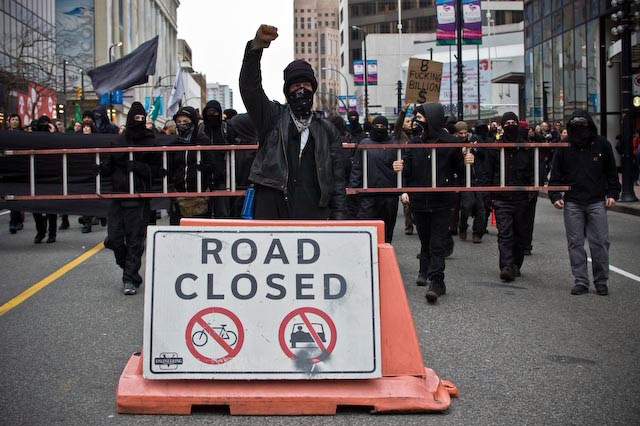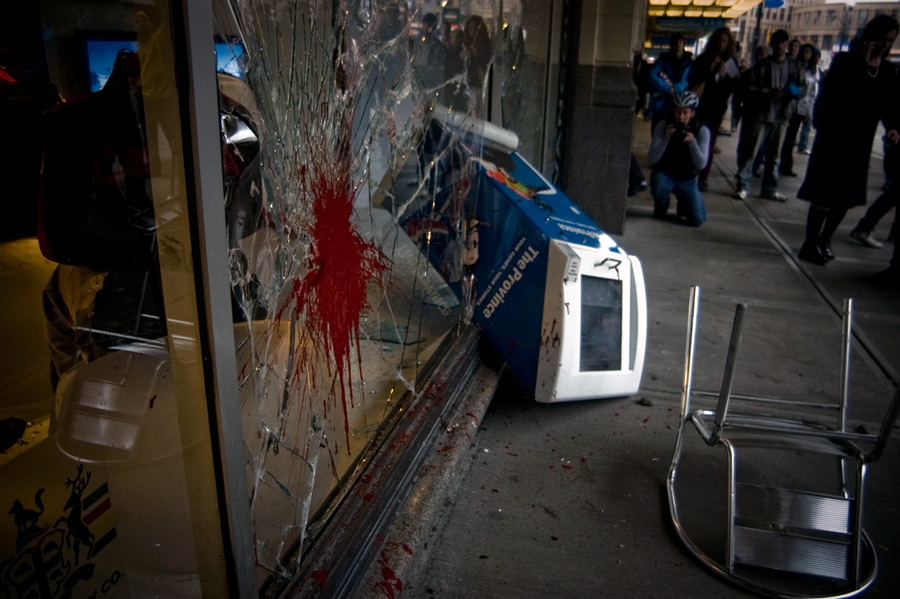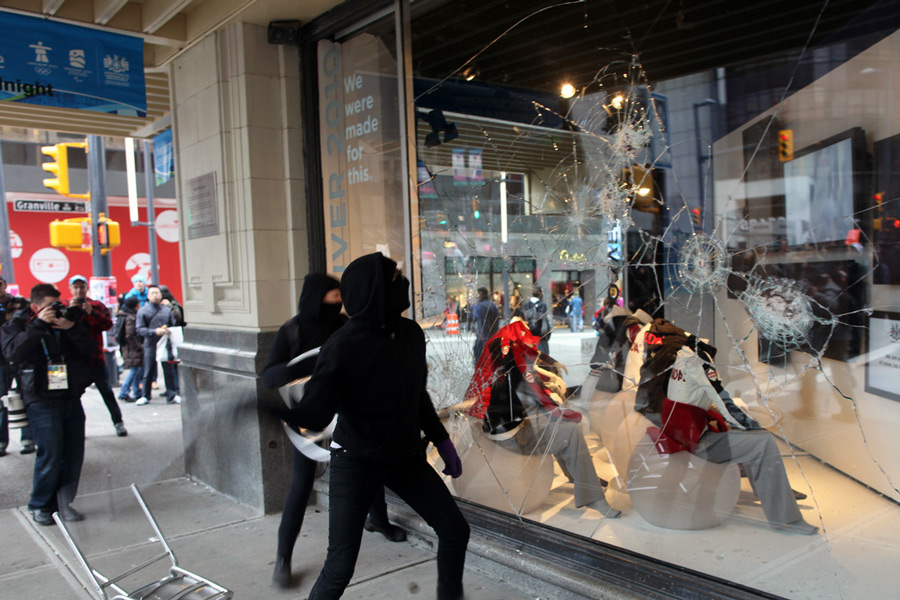
“We love athletics” —anarchist contestants for the 2010 Olympics
We’re pleased to bring you breaking news from Vancouver, where united indigenous and anarchist resistance has disrupted the capitalist and nationalist triumphalism at the opening of the Olympic Games.
Anti-Olympic Riots and Militant Actions Rock Vancouver, Coast Salish Territories
The following report was collectively produced by several participants in this past weekend’s militant resistance to the 2010 Olympic games. This is not a full analysis of Olympic Resistance but rather an in-depth account of what just went down. For more background on why people are resisting these games, check no2010.com and olympicresistance.net.
This was not “just another summit”—this was the culmination of several years of direct action by indigenous people, anarchists, anti-poverty activists, environmentalists, and others against the 2010 Olympics. One of the most inspiring aspects of this convergence was the framework that created it. Unlike many summits, which lack an anti-racist and anti-colonial analysis, indigenous sovereignty and decolonization was front-and-center this time. Indigenous people called upon their allies to help defend their territory against further colonization, and solidarity activists answered that call. An anti-capitalist analysis permeated the entire movement and it was a radicalizing force among the broader activist community. This was not a showdown in which local issues were left on the back burner; as far as the authors know, this was the first summit in North America that was entirely focused on local issues.
The movement was mostly local, as well. Although the numbers may seem small in comparison to mobilizations in Europe and the US, Vancouver is a very isolated city and is not easy to travel to—as many who have tried know. A border separates it from every other major urban center on the West Coast, and the guards turned away countless people hoping to join us. It takes several days of traveling by car to reach Vancouver from Canada’s other major urban centers. Although many people did travel here from across Turtle Island [North America, in the colonial lexicon] and even Europe, the majority of the participants were from the immediate vicinity.

Anarchist hurdles

Anarchist bowling
February 12: First Day of Action
The first official day of action for the Anti-Olympics Convergence was quite a busy day. After the torch run was successfully blocked in two different neighborhoods, thousands of Anti-Olympics dissidents marched on the opening of the games.
8:30 a.m. Hundreds of downtown Eastside residents, including native warriors, anarchists, and other supporters successfully blockaded the intersection of East Hastings and Cambie Street. When police attempted to disperse the crowd by force, some stood their ground while others sat down in the middle of the intersection, refusing to comply with the police orders. Unable to clear the street, the police were forced to tell the torch relay to change its route and not travel down Hastings into the downtown Eastside.
A fascinating bird’s-eye-view of this blockade from start to finish is available here.
9 a.m.

Local residents and other protesters successfully keep the Olympic torch off Commercial Drive.
Hundreds, including many anarchists, took the streets and used barbed wire and boulders to block the torch from coming through their neighborhood. Once word came in that the torch was being re-routed, they moved up Commercial Drive to ensure that it would not get around them and up the Drive. They met a line of mounted police (chant: “Get those animals off those horses!”), but ran through an adjacent alley to take the streets again. A minor confrontation occurred with a few Olympics enthusiasts. The torch was successfully kept off Commercial Drive, and when torchbearer Carrie Serwetnyk arrived she was chased out of the neighborhood and had to be escorted into the back of a police cruiser with torch in hand.
3 p.m.: Take Back Our City Mass Mobilization

Traffic cone contends for the high jump gold medal at the opening ceremonies.
Several thousand protesters, including one hundred in a black bloc, assembled at the epicenter of the Olympic circus at 3 p.m. Led by indigenous elders, they marched from the Vancouver Art Gallery to disrupt the opening ceremonies of the 2010 Olympics at BC Place. The participants respected the call that this be an all-ages, family-friendly demo. However, in contrast to many demonstrations, “family-friendly” did not mean imposed pacifism. This march respected the autonomy of all, and there was a great deal of communication between various groups in order to mutually support each other.
In response to a request for people to move to the front in order to protect indigenous elders from police harassment, the black bloc and native warriors faced off with the pigs. The black bloc contingent was organized, closing ranks and holding police at bay. Members confiscated officers’ hats, vests, and flashlights while tossing orange pylons, tires, and other debris their way—simultaneously mocking the display of state force and inspiring, supporting, and defending those around them. After a long pushing match during which police officers and protesters exchanged blows, it was clear that the conflict was in a stalemate and the crowd began to disperse. Police managed to kidnap three people who were charged with breach, and one with assault.
February 13: Heart Attack!

Black bloc intent on “clogging the arteries of capitalism.”
8:30 a.m. 400 anarchists arrived bright and early at Thornton Park at 8:30 a.m. for the “Heart Attack” demonstration. Calling for a diversity of tactics to “clog the arteries of capitalism,” the march was intended to cause mayhem and attack the corporate heart of downtown Vancouver. After giving time and cover for everyone to “block up” and practicing a turn-around drill in case it was necessary to reverse direction, the march immediately took over both directions of Main Street and moved north towards East Hastings. Things got off to a slow start, with only minor debris being dragged into the street. A marching band arrived and joined the ranks of black-clad militants chanting “What’s the direction? Insurrection! What’s the solution? Revolution!” Marchers tricked the police into thinking they were heading towards the police station. As police scrambled to protect their fortress, the march headed west on East Hastings—through Canada’s poorest neighborhood—towards the intended target: the heart of Vancouver.
As people gained confidence, they started dragging everything that wasn’t bolted down into the streets in order to block police vehicles from following in their wake. Some began spray-painting buses and attacking luxury cars. No damage was done to any buildings in this neighborhood, however. Heart Attackers were received with popular support, and many downtown Eastside residents felt inspired by our presence and joined in.
Arriving at Victory Square, the scene of the previous morning’s successful Olympic Torch blockade, the march took a left up Cambie Street. The energy intensified as it entered more opulent territory, and more property being damaged. A dumpster was dragged out of an alley, spray-painted, and overturned in the middle of the street, as police nervously looked on. Officers kept their distance from the unruly crowd, however, which was now smashing parking meters, defacing billboards, and continuing to obstruct intersections with newspaper boxes.

What dumpsters were to the Pittsburgh G20, newspaper boxes were to the Heart Attack march in Vancouver.
The party really got started as the ungovernables turned onto Georgia Street and made their way closer to Vancouver’s Olympic celebration zone. This hub of capitalism features many flagship stores of Olympic sponsors and is the central gathering point for Olympic tourists and enthusiasts. The streets were crowded with these consumers, and the arrival of the march was hardly met with the same level of support it had received in the downtown Eastside. At this point several belligerent individuals attempted to interfere with the march, leading to physical and verbal confrontations. Some of these vigilantes tried to unmask demonstrators, but were met with overwhelming resistance and forced off the street. One man attempted to incite other Olympic supporters to confront us but couldn’t garner any support and had to settle for urging police to “go get these guys.”

We were made for this.
The march made it fourteen blocks down Georgia Street, wreaking havoc upon the Olympic spectacle. As newspaper boxes continued to appear in the street, chairs, lumber, a ladder, and other instruments were seized from our surroundings in order to escalate the conflict. Having pierced the pericardium, the bloc attacked the aorta, smashing in the windows of the Hudson’s Bay Company’s Olympic department store in front of thousands of shocked upper-class spectators. At this point newspaper boxes ceased to function merely as passive blockades, as anarchists gave them wings and sent them flying through the windows of Hudson’s Bay and a TD bank. This attack on the intersection of Granville and Georgia—the pulse of corporate Vancouver—broke the spell of the Olympic delusion.
As the march proceeded west towards the Lions Gate bridge and the Westin Bayshore hotel, which housed the International Olympic Committee, riot cops appeared in greater numbers, attempting unsuccessfully to flank the crowd on the left. One demonstrator blocked the path of the police and was shoved, initiating hand-to-hand streetfighting. The pig who had initiated the conflict was immediately punched in the face by a member of the black bloc, and was forced to retreat as he realized he was surrounded by militants ready to defend their comrades. Soon after this confrontation a line of riot cops blocked the street ahead. Boxed in with nowhere to go but through the line, many of the black bloc ran, kicked, punched, and scrambled their way to the other side.
Unfortunately, not all were able or willing to fight their way through. As cops attempted to make arrests, all hell broke loose with anarchists on both sides of the line coming to defend and de-arrest their comrades, fighting the police for control of the intersection. This intensity of hand-to-hand conflict between anarchists and police has not been seen in “Canada” for nearly a decade. Several of the de-arrests were successful, but a handful of arrests were effected. In the end, the police held the intersection, successfully fragmenting the rioters into smaller and more vulnerable groups. Many dispersed at this point, but a group of approximately one hundred, including a festive marching band, were able to continue south, looping around to head west on Robson. Over an hour later, this group was surrounded and detained by riot cops; the police were eventually forced to release them by bystanders and supporters chanting “let them go.”
Subsequent Repression
Immediately following the dispersal, police attempted to use any excuse they could to harass, detain, and arrest suspected rioters, legal observers, media, and organizers. Several people were snatched off the street while leaving the intersection of Robson and Jervis. A few hours later, Gord Hill was given a $115 ticket for swearing at a police officer who was making an arrest outside of the Vancouver Media Co-op. Another known organizer was arrested on E. Hastings for “riding a bike on a sidewalk.” He was then charged with obstruction as he stood up for a homeless man who was being hassled by Police in Pigeon Park. Two legal observers were also ticketed for jaywalking on E. Hastings.
A reconvergence of the Heart Attack march had been planned for Robson and Granville at 5 p.m. that evening. However, it was canceled due to a variety of factors including the arrests, the increased repression, and the fact that police knew about this reconvergence point and would likely be eager to make more arrests. Those who did appear were illegally detained by riot police in front of thousands of Olympic spectators, but were released after a short period of time.
The following day, several people were snatched in relation to the Heart Attack demo, and police are still investigating videotapes and looking for more victims. We hope they won’t find any.
Also on Sunday, about 5000 participated in the 19th annual Women’s Memorial March, honoring missing and murdered women from Vancouver’s downtown Eastside. Led by indigenous women, this event was not an explicitly anti-Olympic protest, but many anarchists and other protesters participated.
Post-Action Debrief
As some had predicted, the primary tactic of the police was fear. They did not use the LRAD they had purchased; they never used tear-gas, rubber bullets, or any other form of long-range combat tactics. When they did attempt to control or arrest protesters, they used a hands-on approach. It was clear to some of us that they desired to avoid images of Vancouver engulfed in tear gas during the first day of the Olympic Games. The Olympics are all about nationalist propaganda, and the whole world actually is watching, unlike at most other demonstrations. Even with their billion-dollar security budget and high-tech crowd-control weapons, the police were unable to prevent a riot that had been announced years in advance. They effectively had their hands tied.
The black bloc relied heavily on what was readily available to them in the streets instead of bringing their own materials into the demo. Unfortunately, there were no mass supplies—no hard banners, paint bombs, projectiles, batons, or bandanas—to share with others who wanted to join.
One criticism was that people kept attacking the same windows, even throwing paint bombs at them after they were already smashed, instead of using that energy and opportunity to destroy additional property. A window that is smashed, has paint on it and a newspaper box through it does make a great photo-op, but smashing windows at a protest can be quite risky. If you’re brave enough to take that kind of action, make sure it counts!
The original target for the Heart Attack march had been the intersection of Denman and Georgia, in hopes of blocking traffic in and out of the Lions Gate Bridge, a major artery leading to the Olympic Games. Blocking the bridge turned out to be unachievable, but the march did succeed in clogging the arteries of Vancouver commerce in general. Considering the scale of militant confrontation, anarchists suffered very few arrests—at least thus far.
On the other hand, yet again the call for decentralized actions didn’t produce widespread resistance—at least as far as we know at this moment. Many anarchists argued that it would be easier to act in cells in their respectful communities and target corporate sponsors as the security apparatus would be concentrated in Vancouver. However, it is undeniable at this time of writing that the most effective resistance yet has been at the convergence itself.
This is only a preliminary assessment of this convergence. There are many other actions and demonstrations planned, and we won’t know the full scale of everything until the dust settles. The Olympics continue in Vancouver for two weeks. There is still time to plan solidarity actions. A list of corporate sponsors can be found here. A full assessment of this movement, the involvement of anarchists, and what it means for the future of militant struggle in “Canada” will appear in the near future.

Anarchists to pigs: Get the fuck out of our community!
Further Coverage Vancouver Media Coop Friendly Fire Collective Insurgent Photo
[Banner photo by Michael Thibault, Crimson Phoenix Photography, www.crimsonphoenixphotography.com.]


